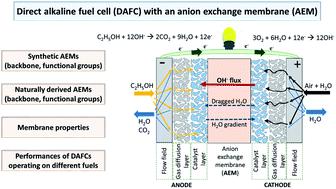当前位置:
X-MOL 学术
›
Sustain. Energy Fuels
›
论文详情
Our official English website, www.x-mol.net, welcomes your feedback! (Note: you will need to create a separate account there.)
Alkaline membrane fuel cells: anion exchange membranes and fuels
Sustainable Energy & Fuels ( IF 5.6 ) Pub Date : 2020-11-16 , DOI: 10.1039/d0se01373k Maša Hren 1, 2, 3, 4, 5 , Mojca Božič 4, 5, 6 , Darinka Fakin 1, 2, 3, 4, 5 , Karin Stana Kleinschek 1, 4, 5, 7, 8 , Selestina Gorgieva 1, 2, 3, 4, 5
Sustainable Energy & Fuels ( IF 5.6 ) Pub Date : 2020-11-16 , DOI: 10.1039/d0se01373k Maša Hren 1, 2, 3, 4, 5 , Mojca Božič 4, 5, 6 , Darinka Fakin 1, 2, 3, 4, 5 , Karin Stana Kleinschek 1, 4, 5, 7, 8 , Selestina Gorgieva 1, 2, 3, 4, 5
Affiliation

|
Alkaline anion exchange membrane fuel cells (AAEMFC) are attracting ever-increasing attention, as they are promising electrochemical devices for energy production, presenting a viable opponent to the more researched proton exchange membrane fuel cells (PEMFCs). Consequently, great progress has been made in the area of designing and developing synthetic or naturally-derived anion exchange membrane (AEM), the properties of which have been discussed in this review, i.e. ionic conductivity, ion exchange capacity, fuel crossover, durability, stability and cell performance. Major groups of natural polymers (e.g. chitosan (CS)) and nanocellulose, together with modification/crosslinking routes, have been mentioned as more ecologically and economically viable raw materials for AEM processing compared to synthetic ones. Performances of fuel cells are also discussed, with different fuels used as anode feeds. Although the AEMFC technology is promising, the longevity challenges remain, originating from the still-limited long-term stability of hydroxide-conducting ionomers, particularly when operating at higher cell temperatures.
中文翻译:

碱性膜燃料电池:阴离子交换膜和燃料
碱性阴离子交换膜燃料电池(AAEMFC)吸引了越来越多的关注,因为它们是用于产生能量的有希望的电化学装置,与研究较多的质子交换膜燃料电池(PEMFC)形成了可行的对手。因此,很大的进步已经在设计和开发合成的或天然衍生的阴离子交换膜(AEM),其性能已在此综述中讨论,方面取得即离子传导性,离子交换容量,燃料交叉,耐久性,稳定性和电池性能。天然聚合物的主要类别(例如与合成原料相比,壳聚糖(CS))和纳米纤维素以及修饰/交联途径已被认为是用于AEM加工的更具生态和经济可行性的原料。还讨论了燃料电池的性能,其中将不同的燃料用作阳极进料。尽管AEMFC技术前景广阔,但长寿挑战仍然存在,这源于仍然有限的氢氧根离子离聚物的长期稳定性,特别是在较高的电池温度下操作时。
更新日期:2020-11-25
中文翻译:

碱性膜燃料电池:阴离子交换膜和燃料
碱性阴离子交换膜燃料电池(AAEMFC)吸引了越来越多的关注,因为它们是用于产生能量的有希望的电化学装置,与研究较多的质子交换膜燃料电池(PEMFC)形成了可行的对手。因此,很大的进步已经在设计和开发合成的或天然衍生的阴离子交换膜(AEM),其性能已在此综述中讨论,方面取得即离子传导性,离子交换容量,燃料交叉,耐久性,稳定性和电池性能。天然聚合物的主要类别(例如与合成原料相比,壳聚糖(CS))和纳米纤维素以及修饰/交联途径已被认为是用于AEM加工的更具生态和经济可行性的原料。还讨论了燃料电池的性能,其中将不同的燃料用作阳极进料。尽管AEMFC技术前景广阔,但长寿挑战仍然存在,这源于仍然有限的氢氧根离子离聚物的长期稳定性,特别是在较高的电池温度下操作时。



























 京公网安备 11010802027423号
京公网安备 11010802027423号